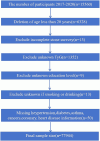Elevated TyG index associated with increased prevalence of gallstones in a United States cross-sectional study
- PMID: 38883189
- PMCID: PMC11177685
- DOI: 10.3389/fpubh.2024.1351884
Elevated TyG index associated with increased prevalence of gallstones in a United States cross-sectional study
Abstract
Objective: This study aimed to investigate the correlation between the triglyceride-glucose (TyG) index and the incidence of cholelithiasis.
Research approach: In this investigation, a cross-sectional analysis was undertaken utilizing data from the US National Health and Nutrition Examination Survey (NHANES) spanning the years 2017 to 2020. The TyG index served as an independent predictor, while gallstone prevalence was considered the dependent variable of interest. We employed a multivariate logistic regression model to evaluate the interplay between these independent and dependent variables. To assess the presence of potential non-linear associations, sensitivity analysis was executed, utilizing inverse probability weighted validation, smooth curve fitting, and threshold effect analysis. In cases where non-linear relationships were observed, likelihood ratios were utilized to pinpoint potential inflection points. Ultimately, subgroup analyses were conducted to identify specific populations demonstrating heightened susceptibility to gallstone prevalence.
Results: Encompassing 838 patients who self-reported gallstones, a total of 7,794 participants were included in the analytical cohort. A statistically significant disparity in the TyG index was observed when all individuals were categorized into gallstone patients and non-patients (p < 0.05). Logistic regression findings indicated a positive correlation between the TyG index and gallstone disease prevalence (OR = 1.28, 95% CI: 1.12, 1.47), with a strengthening association as the TyG index increased (p trend <0.01). The results were corroborated by the use of inverse probability weighting. Additionally, a non-linear connection between the TyG index and gallstone prevalence was identified (log-likelihood ratio p < 0.01), with the optimal inflection point for TyG calculated at 8.96. In subgroup analysis, the positive relationship between the TyG index and gallstone prevalence was notably pronounced among black Americans under the age of 40 and female participants.
Conclusion: Alterations in the TyG index may potentially correlate with shifts in the prevalence of gallstones among adult populations in the United States. Elevated TyG index values may coincide with an augmented likelihood of gallstone occurrence.
Keywords: NHANES; cross-sectional study; gallstones; insulin resistance; triglyceride glucose index.
Copyright © 2024 Feng, Wu, Ke and Liang.
Conflict of interest statement
The authors declare that the research was conducted in the absence of any commercial or financial relationships that could be construed as a potential conflict of interest.
Figures



Similar articles
-
Relationship of triglyceride-glucose index to gallstone prevalence and age at first gallstone surgery in American adults.Sci Rep. 2024 Jul 20;14(1):16749. doi: 10.1038/s41598-024-67883-0. Sci Rep. 2024. PMID: 39033195 Free PMC article.
-
Association between triglyceride glucose index-related indices with gallstone disease among US adults.Lipids Health Dis. 2024 Jun 27;23(1):203. doi: 10.1186/s12944-024-02194-x. Lipids Health Dis. 2024. PMID: 38937793 Free PMC article.
-
Association between triglyceride-glucose index and gallstones: a cross-sectional study.Sci Rep. 2024 Aug 1;14(1):17778. doi: 10.1038/s41598-024-68841-6. Sci Rep. 2024. PMID: 39090272 Free PMC article.
-
The triglyceride-glucose index and risk of cognitive impairment: a systematic review and meta-analysis with inclusion of two national databases.Front Neurol. 2024 Nov 29;15:1496871. doi: 10.3389/fneur.2024.1496871. eCollection 2024. Front Neurol. 2024. PMID: 39677858 Free PMC article.
-
Risk Factors for Gallstones in Crohn's Disease: A Systematic Review and Meta-Analysis.Dig Dis Sci. 2024 Nov;69(11):4187-4202. doi: 10.1007/s10620-024-08597-1. Epub 2024 Sep 25. Dig Dis Sci. 2024. PMID: 39322804
Cited by
-
Association between various insulin resistance surrogates and gallstone disease based on national health and nutrition examination survey.Sci Rep. 2025 Jul 16;15(1):25877. doi: 10.1038/s41598-025-09482-1. Sci Rep. 2025. PMID: 40670519 Free PMC article.
-
Association between platelet-to-high-density lipoprotein cholesterol ratio and gallstone prevalence in the American adult population: a cross-sectional study analysis.BMC Gastroenterol. 2025 Apr 25;25(1):297. doi: 10.1186/s12876-025-03930-y. BMC Gastroenterol. 2025. PMID: 40281441 Free PMC article.
-
Cardiometabolic index as a predictor of gallstone incidence in U.S. adults: insights from NHANES 2017-2020.BMC Gastroenterol. 2025 Jan 29;25(1):45. doi: 10.1186/s12876-025-03642-3. BMC Gastroenterol. 2025. PMID: 39881275 Free PMC article.
-
An association between average daily sleep duration and gallstones in US adults.Sci Rep. 2025 Feb 7;15(1):4573. doi: 10.1038/s41598-025-89157-z. Sci Rep. 2025. PMID: 39915625 Free PMC article.
-
Gallbladder pathologies through a decade: Insights into emerging trends and premalignant lesions from a single-center experience: An observational study.Medicine (Baltimore). 2025 Aug 1;104(31):e43507. doi: 10.1097/MD.0000000000043507. Medicine (Baltimore). 2025. PMID: 40760549 Free PMC article.
References
MeSH terms
Substances
LinkOut - more resources
Full Text Sources
Medical

